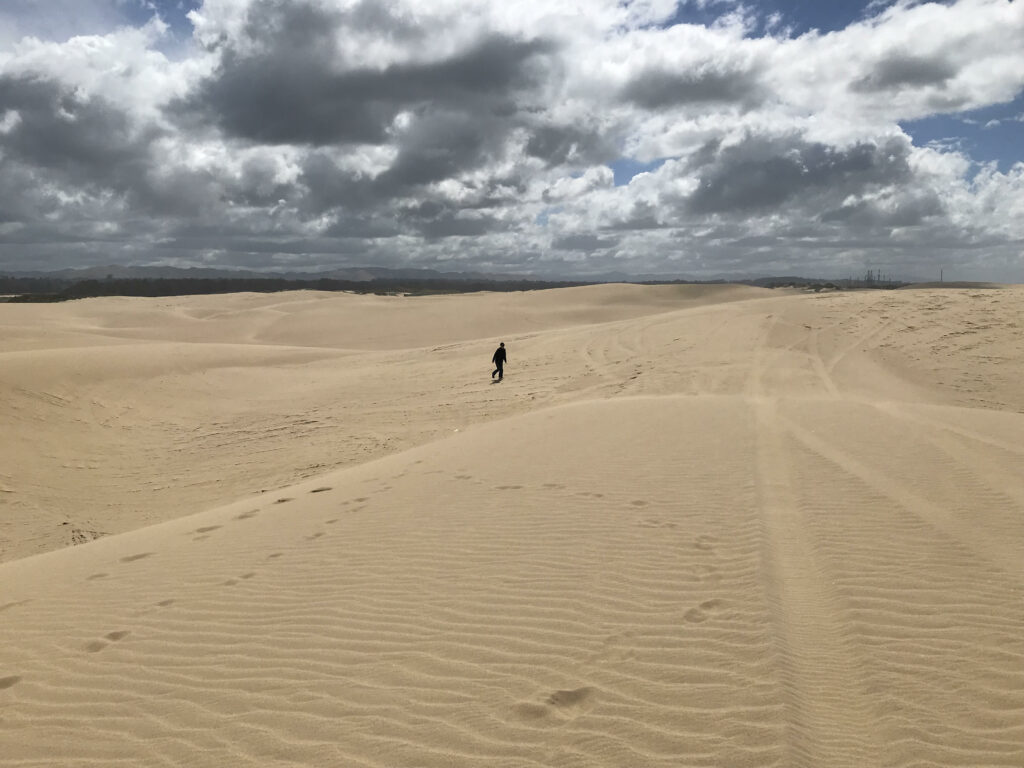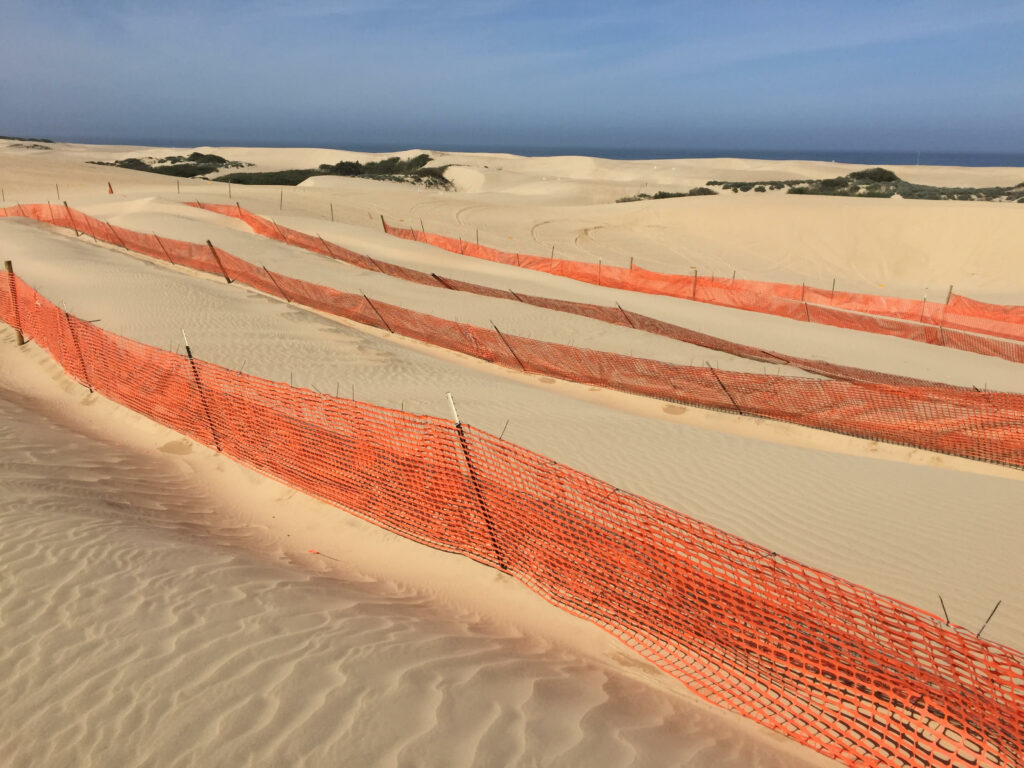California Coastal Commission unfazed by air district’s changing dust excuses
July 9, 2020

By KAREN VELIE
The California Coastal Commission is moving ahead with plans to reduce sand blowing on the Nipomo Mesa, even though there appears to be almost no chance the mitigation efforts will be effective.
In 2018, State Parks entered into a stipulated order of abatement with San Luis Obispo County’s Air Pollution Control District (APCD). The order mandates that the state reduce wind-blown dust, specifically dust particles that are 10 microns or less in diameter, on the Nipomo Mesa by 50 percent. However, APCD Administrator Gary Willey admitted last month that the abatement goal could not be achieved.
As part of the abatement agreement, state parks covered about 200 acres of dune sand with ground cover and orange plastic fencing, which required a permit approved by the Coastal Commission. Additional acres of the dunes are expected to be covered in the coming years if APCD and Coastal Commission staff have their way.
Some coastal commissioners, spurred by false reports about the cause of the dust and its chemical composition, began debating whether the Oceano Dunes State Recreational Area should be partially or completely shuttered.
A decade ago, the APCD first claimed it had tied high off-road vehicle traffic at the Oceano Dunes State Recreational Area to higher levels of dust on the Nipomo Mesa.
In March 2010, the APCD released a 12-month study of recreational vehicles on the Oceano Dunes. In its summary, the APCD said data showed that on weekends and holidays with more off-road vehicle activity, more dust blew onto the Nipomo Mesa, according to the South County Phase 2 Particulate Study.
“A comprehensive study to determine the source of particulates impacting the mesa was conducted in two phases, beginning in 2004,” according to the study. “Extensive analysis of the study data resulted in a conclusive finding that off-road vehicle activity at the Oceano Dunes State Vehicle Recreation Area is a major contributing factor to the high PM concentrations observed on the mesa.”
However, a later review of the data showed a 13-month study, with the windy month of March listed twice, and no correlation between off-road vehicle activity on the dunes and higher levels of dust on the mesa.
Following the rebuke, the APCD claimed that the dunes emit dust from strong, easterly winds blowing the sand, and that more dust is created by driving off-road vehicles on the dunes.
In its Phase 2 study, the APCD also compared the Oceano Dunes with a dry lake bed. The APCD alleged that without traffic on the dunes, the sand would develop a crust similar to the salt flats of Owens Lake in the high desert of Eastern California.
The closure of the Oceano Dunes to all off-road and recreational vehicles in March also provided evidence that rebuked both the APCD’s dust emission and geographically misplaced crust theories.
Since RVs and off-road vehicles were barred from the Oceano Dunes because of the coronavirus, violations for excessive dust have more than doubled, data from two Nipomo Mesa air quality monitoring sites show. In addition, the dunes have not formed a crust similar to the salt flats of Owens Lake.

In 2018, the APCD formed a panel of scientific advisors, known as the Scientific Advisory Group (SAG), to assist in the design and implementation of the various dune-covering projects.
In apparent anticipation that continued high-dust days with no vehicle recreation in the dunes would lead the public to question the APCD’s conclusions, the SAG reported that a lack of off-road vehicle activity on the dunes may not effect dust levels on the mesa, in an April 6 memorandum.
The APCD and SAG’s current theory is that off-road vehicles have damaged the dunes, which could take decades to heal. Neither entity detailed what “damage” meant, nor did they explain how the damage correlates to higher dust levels on the mesa.
“The SAG acknowledges that the Oceano Dunes are a naturally dusty surface that would experience PM emissions even in the absence of human activity, especially during this spring windy season,” according to the memorandum. “But the SAG is also clearly aware that decades of OHV activity have fundamentally altered the natural beach-dune landscape, making the dunes significantly more susceptible to PM emissions than they would be in a natural state.”
Even so, California Coastal Commission staff is recommending the board approve a five-year mitigation plan to reduce sand blowing from the Oceano Dunes. The board meets virtually on Thursday at 9 a.m. to discuss the Oceano Dunes.
The meeting is expected to be contentious, with a group of South County residents, who are passionate about keeping vehicles off the dunes, and others who do not like the off-road vehicle enthusiasts who come from the Central Valley, asking the commission to close the Oceano Dunes to off-road vehicles.
On the other side, campers and off-road vehicle enthusiasts argue that the California Coastal Commission is not following its mission of providing coastal access to all, and instead, only to those they identify with politically, according to Michael McGarity, a dunes rider from the valley.
“We are all told to stay in our valley,” McGarity said. “We must fight now to protect our access against disproportionately unreasonable forces. To make matters worse, we are, as a group, targeted, hated, insulted and called names.”
Limits of Coastal Commission’s authority over Oceano Dunes explained
The primary author of the Coastal Act and the California Coastal Commission’s first executive director, Peter Douglas, explains the limits of the Coastal Commission’s authority over the Oceano Dunes on Feb. 8, 2008.
Sign up for breaking news, alerts and updates at Cal Coast News Top Stories.






The comments below represent the opinion of the writer and do not represent the views or policies of CalCoastNews.com. Please address the Policies, events and arguments, not the person. Constructive debate is good; mockery, taunting, and name calling is not. Comment Guidelines